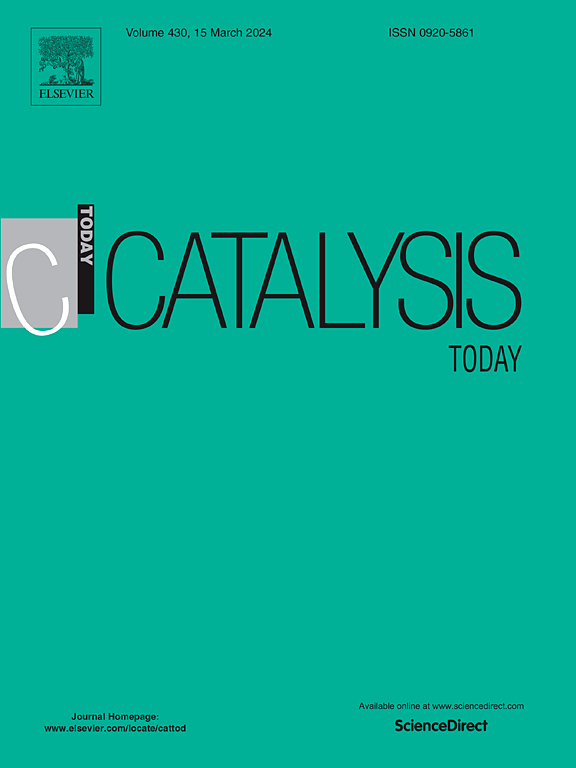钯膜反应器中Ni/MgAl2O4催化剂上乙醇稳定生物油的蒸汽重整
IF 5.3
2区 化学
Q1 CHEMISTRY, APPLIED
引用次数: 0
摘要
采用新型膜反应器(MR)在Ni/MgAl2O4催化剂上对25 wt%乙醇稳定的生物油原料进行蒸汽重整(SR),并与常规反应器(CR)进行了比较(H2和副产物气体的产率)。反应设置包括两个步骤:一个向下流动管(500℃)用于进料蒸发和控制从生物油中的含氧物中去除热解木质素(PL),然后是一个向上流动的反应器,该反应器由多孔不锈钢(PSS)管支撑的复合Pd膜支撑,该管含有CeO2中间层(Pd/CeO2/PSS)。在MR结构下(绝对渗透压力为0.2 bar),在550℃、2.8 h、S/C比为1.55和3 bar条件下,H2产率达到82 %。即使在1 bar和600ºC下,该结果也显着提高了CR达到的结果。当S/C比增加到2.2时,必须限制进料中的S/C比,以避免较高的气体稀释和浓度极化效应对H2通过pd膜的通量造成限制。同样,较高的保留压力对H2产率有负面影响,因为它对甲烷SR平衡的负面影响,抵消了它对H2通过膜的渗透的好处。该膜和催化剂具有良好的性能,在木质纤维素生物质可持续制氢方面具有良好的应用前景。本文章由计算机程序翻译,如有差异,请以英文原文为准。
Steam reforming of bio-oil stabilized with ethanol over a Ni/MgAl2O4 catalyst in a Pd-membrane reactor
A new membrane reactor (MR) has been used in the steam reforming (SR) of a feed of raw bio-oil stabilized with 25 wt% ethanol over a Ni/MgAl2O4 catalyst, comparing the results (yield of H2 and byproduct gases) to those reached in a conventional reactor (CR). The reaction setup involves two steps in series: a down-flow tube (at 500 ºC) for the vaporization of the feed and controlled removal of pyrolytic lignin (PL) from the oxygenates in the bio-oil, followed by an up-flow reactor provided with a composite Pd membrane supported on a porous stainless steel (PSS) tube containing a CeO2 intermediate layer (Pd/CeO2/PSS). In the MR configuration (with permeate pressure of 0.2 bar absolute), a H2 yield of 82 % was achieved at 550 ºC, space time of 2.8 h, S/C ratio of 1.55 and 3 bar in the retentate (reactor). This result significantly improves those reached in CR, even at 1 bar and 600 ºC. The S/C ratio in the feed must be limited in the MR configuration to avoid restrictions in H2 flux through the Pd-membrane caused by a higher gas dilution and concentration-polarization effect, as observed when the S/C ratio is increased up to 2.2. Similarly, a higher retentate pressure has a negative effect on the H2 yield due to its negative impact on the equilibrium of methane SR, that overcomes its benefits on the H2 permeation through the membrane. A promising performance of the membrane and catalyst has been obtained, thus demonstrating good prospects for their use in the sustainable production of H2 from lignocellulosic biomass.
求助全文
通过发布文献求助,成功后即可免费获取论文全文。
去求助
来源期刊

Catalysis Today
化学-工程:化工
CiteScore
11.50
自引率
3.80%
发文量
573
审稿时长
2.9 months
期刊介绍:
Catalysis Today focuses on the rapid publication of original invited papers devoted to currently important topics in catalysis and related subjects. The journal only publishes special issues (Proposing a Catalysis Today Special Issue), each of which is supervised by Guest Editors who recruit individual papers and oversee the peer review process. Catalysis Today offers researchers in the field of catalysis in-depth overviews of topical issues.
Both fundamental and applied aspects of catalysis are covered. Subjects such as catalysis of immobilized organometallic and biocatalytic systems are welcome. Subjects related to catalysis such as experimental techniques, adsorption, process technology, synthesis, in situ characterization, computational, theoretical modeling, imaging and others are included if there is a clear relationship to catalysis.
 求助内容:
求助内容: 应助结果提醒方式:
应助结果提醒方式:


